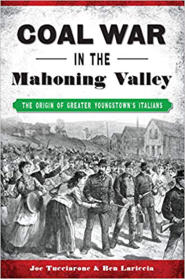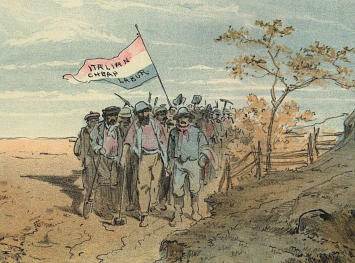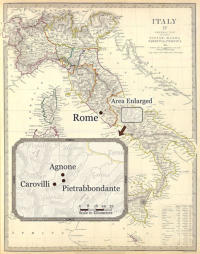Italian American Press
Founded in 2001 Italian and Italian American Authors
Italian and Italian American Books
The Italian American Press
specializes in offering a
selection of books primarily
written by authors of Italian
heritage who write about
Italian American and Italian
culture, heritage, and
history. Many of these
authors are independent
publishers and market their
own books.
Reading stories of Italian
American culture and
history will educate, inform,
and entertain people of all
nationalities.


ABOUT US CONTACT FOR AUTHORS ADVERTISERS



Featured Authors
Interview
Joe Tucciarone and Ben Lariccia
Coal War in the Mahoning Valley

What is the most important attribute of the book?
Ben: The book is a rediscovery of a lost local history with national implications, thoroughly footnoted with many historical images and
detailed maps.
Joe: A few hundred penniless Italian immigrants made a huge impact in the industrial history of the United States. The events of 1872-1873
triggered an ever-growing influx of immigrants from Italy. American businessmen were happy to employ the newcomers, who in turn, were
happy to receive better pay than they could get in their home country.
What made you decide to work together on the book?
Ben: Joe and I agreed that “Coal War” was a story that needed to be told, and that the very ignorance of this history compelled us to publish it.
Both descendants of Italian immigrants who had settled in the Mahoning Valley, we were familiar with some of the sites where the labor conflict
broke out. Early in our work together, Joe shared with me his article The First Italians in Trumbull County. I was impressed by its point of view
and literary style. I had a sense that composing with him would result in a well written book.
Joe: Ben and I are both descended from Italians who settled in the Mahoning Valley, and we both have a keen interest in the history of those
immigrants. We exchanged notes and soon realized that we had a significant story to tell, about immigrants, coal mines and strikes.
How did you divide the research and writing?
Ben: Joe had done the bulk of the research, plus he had adapted images and maps to illustrate some of the sites and events in the newspaper
clips. I had experience writing for publication. We both submitted text and edited together. I also took on the task of reading resources on Italian
emigration published in Italian. He continued editing images and maps.
Joe: Every week, we met via Skype, since I live in Florida and Ben lives in Pennsylvania. We would discuss the events we'd been researching,
and at the end of each session, we both had a list of things to do. "Homework" is what I called it!

Why should someone read it?
Joe: We have unveiled a history that has been largely lost over the last 140 years.
We've shown that the first Italian immigrants who settled in and around Youngstown
didn't arrive as tourists, nor were they immediately welcomed.
Ben: Italians immigrating to the U.S. in the 1870s encountered conditions that were
different from those who arrived later. Coal War offers the reader a view of those
differences. Moreover, our book details events in Italy that triggered this early
exodus. In fact, we trace a small group of wayfarers from their town of Agnone all the
way to the mines of Coalburg, Trumbull County. Sadly, once here, the early Italians
were pigeonholed as strikebreakers, a practice that caused a considerable amount
of prejudice against them. This occurred at a time when the labor movement in the
U.S. was just taking off.


From a study by Ben and Joe
For all of them, as for many in southern Italy, and especially in Agnone, the 1870s were very difficult years.
But despite all the challenges … they would eventually leave Italy and settle in the Mahoning Valley in 1873.

Joe Tucciarone and Ben Lariccia
The 1861 Unification of Italy launched a new European
country promising to fulfill the dreams of millions of
Italians. As the young Kingdom of Italy modernized, it
ended feudalism, a move that opened many
opportunities. But a large sector of poor peasants found
themselves cutoff from the changed order and
desperate to survive. In 1872, an army of speculators
invaded the countryside, hawking steamship tickets and
promising fabulous riches in the Americas.
Italians Swindled to New York:
False Promises at the Dawn of Immigration

Interview
Joe Tucciarone and Ben Lariccia
Italians Swindled to New York

Liberty Township: The 1873 Coal War and the Italians (January 2018)
“In the Mahoning Valley, there’s a layer of fine coal dust that overlays Italian American history. To
retrace the time when Italians first arrived, head north on Youngstown’s Belmont Avenue and
you’ll soon find yourself on Route 193. In Liberty Township, not far from where the highway
crosses Churchill Road, stood Church Hill and its coal camp. The events that took place there,
forgotten for decades, deserve a retelling.”
(Click on title above to read article on La Gazzetta Italiana.)
Trumbull Coal was King Before Youngstown Steel
Book Overview on La Gazzetta Italiana
Why did they abandon their native land and how did they arrive in the Greater Youngstown area?
(Click on title below to read article on La Gazzetta Italiana.)
Local Italian American History: From Agnone to Hubbard Township (Part 1, June 2018)
Local Italian American History: From Agnone to Hubbard Township (Part 2, July 2018)
What inspired you to write Italians Swindled to New York: False Promises at
the Dawn of Immigration?
Joe: A few months after the publication of our Coal War book in 2019, Ben asked if
we had left any unfinished business as a result of our research. In that book, we
briefly touched on a heartless swindle of Italian peasants that took place in the fall
of 1872. We noted that the scam had grabbed the attention of high-ranking
politicians in both Italy and the United States, so the fraud was obviously a topic that
deserved more attention.
Ben: One of our discoveries in writing Coal War in the Mahoning Valley showed that
the future fate of Italian immigrants was greatly influenced by the experiences of
those who arrived in the first rumblings of mass immigration, the early years of the
1870s. The swindling that we had touched upon in this first book really deserved to
be fully investigated and brought to light in all its particulars.
What is the most important attribute of this book?
Ben: All too often, to emigrate means to put your well-being at the mercy of others
who may exploit your desperation. It’s true today, and it was then for Italians trying
to escape social and economic changes ushered in by Italian Unification. The sheer
scale of exploitation these early arrivals experienced – from the moment hucksters
arrived in villages peddling transatlantic tickets to the conditions immigrants suffered
as strikebreakers and contract laborers in the U. S. – is what you’ll find in Italians
Swindled to New York: False Promises at the Dawn of Immigration.
Joe: We uncovered numerous facts during our research, but the most important
one was that the well known mass-migration of Italians to the United States began
almost eight years earlier than has been widely believed. Years of dispossession,
high taxation and other privations created a sense of hopelessness among Italian
peasants, but the heartless swindle drove them over the tipping point, triggering
the exodus.
Why should someone read it?
Joe: This is an important chapter in the economic and cultural history of the late
19th century. Our research shows that the massive Italian emigration was sparked
and sustained by the actions of a relatively small number of grifters. A changing
global economy had set a stage upon which an unanticipated human drama would
play out.
Ben: The era before 1880 is little studied, yet it’s directly tied to how Americans, for
decades, came to view Italians. Starting in the early 1870s, our immigrant ancestors
were pigeon-holed into the category of “pauper labor,” a status they shared with
Chinese immigrants and African Americans of the era. To miss the 1870s is to miss
an essential piece of Italian American history.
Was it difficult to access sources?
Ben: Primary resources on the scandalous swindles of the 1870s exist online, and it
was relatively easy to access most of them. For example, Giovanni Florenzano’s
1874 exposé Dell’emigrazione Italiana in America, detailed how poor Italians were
duped into emigrating and at what cost to the newly unified country. Also the spirited
debates in the Italian Parliament on emigration provided important background for
our study. U.S. diplomatic archives of the era proved invaluable.
Joe: In some ways the research was easy, as the history already existed. However,
the facts were widely scattered in newspaper archives, government documents,
museums and personal collections. The challenge was weeding out irrelevant data
and composing the rest into a coherent narrative.
The Italian Parliament began discussing the unprecedented surge in emigration
(caused by exaggerated claims and false promises of shipping agents) in the spring
of 1872. The representatives became aware of shipping agents' frauds late in 1872
and immediately denounced them. Curiously, it took six years before the Chamber
of Deputies and the Italian Senate passed strict laws against this kind of fraud. But
the laws were not enforced, which is why emigration proceeded at a breakneck
pace through the end of the 19th century.
What did the research process entail?
Ben: There exist historical newspaper archives online, from both the English language and the Italian press. Early in the research, we found
contemporary books, periodicals, and governmental records that added to the stories we were reading in the newspaper clips. We wanted to
present the facts on the swindles from more than just a journalist’s perspective. This approach guided us in the research.
How did both of you divide the tasks when researching and writing the book?
Joe: We were fortunate that our skills and interests were distinct yet complementary. So at first, we pursued separate leads that revealed
different aspects of the history. We met every week via Skype to discuss our investigations. New information generated new questions, and
after every session each of us had a list of assignments to complete before our next meeting. It was like being in school again!
Ben: Joe was more familiar with the newspaper documentation describing the duping of emigrants and their later fate in the U.S. as contract
laborers. The question I sought to investigate had to do with the drivers of emigration. We all know that Italians feel very close to their home
villages and towns. What had driven so many to abandon their country, only to unwittingly put their fates in the hands of people who cheated
them? It was apparent from the contemporary sources and from modern studies that critical changes in traditional life followed the 1861
Unification of Italy. We wanted to present the impact of these on Italians and emigration.
Italians Swindled to New York: False Promises at the Dawn of Immigration
Available in Italy
Click on image to enlarge.
What inspired you to write Coal War in the Mahoning Valley?
Joe: Eight years ago, I decided to do some research about my great-
grandfather, Joe Madeline. I knew he operated a saloon in the early
1900s, but nobody knew when he opened it or why he closed it. In an
effort to find answers to my questions, I began searching through
property deeds and newspaper articles. I found the information I
sought, but along the way I also discovered a lot of interesting
information about the first Italian immigrants in the Youngstown area.
That was the genesis of our book.
Ben: I came upon the 1873 Coal Miners’ Strike late. Joe had
discovered the conflict years previous to our getting together. About
three years ago, I began taking note of the amazing digital newspaper
clippings he was sharing with the social media group, Mahoning
Valley Italian Descendants. Although I was an experienced writer on
Italian American subjects, what Joe was posting was new to me. I had
never heard of Italians in the 1870s living in the Mahoning Valley,
where I was born. I was eager to learn more.
The Coalburg Italians
Coalburg, a small mining camp
seven miles north of Youngstown,
Ohio, gained national attention in
March 1873 when a hundred
Italians were brought to its mines.
They were the first Italian settlers in
the Youngstown area.
VIEW VIDEO
NEW VIDEO